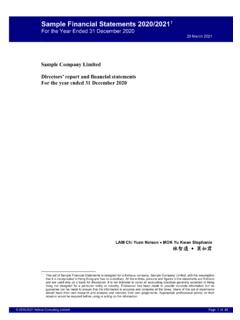Transcription of Explanatory notes - Hempel
1 Explanatory notes Issued by Hempel A/S - April 2020 1/6 Scope These Explanatory notes describe and explain the fields in Hempel s Product Data Sheets (PDS) to ease the understanding of the data provided. The notes explain the content of each field, provide background information and state any definitions, standards and measurement methods that may be of relevance during planning and application of Hempel s products. The reader should be aware that data, directions and recommendations given in the PDS are based on test results or experience obtained under controlled or specifically defined circumstances. Their accuracy, completeness or appropriateness under operational conditions may be different. Product characteristics Description A short description of the product with emphasis on generic type, functionality, basic chemistry, principal properties, advantages and certain limitations.
2 Recommended use The usage for which the product is designed or particularly well suited. The product may be specified for other uses in tailor-made paint systems as outlined in the specification. Service temperature The maximum (and minimum) temperature that will have no immediate detrimental effect on the paint. A service temperature constantly near the maximum value will result in a shorter service life of the specified paint system compared to the same paint system operating at temperatures in the middle of the range. If the service temperature often fluctuates between mid-range temperatures and a temperature close to the maximum value, accelerated ageing (a decrease in the paint system s anticipated service life) is to be expected. Most paints will change appearance when exposed to high temperatures, either by changing colour and/or losing gloss.
3 In addition, many paints will become soft at high temperatures and show higher sensitivity to mechanical or chemical actions. Exposure to warm liquids, including water, is normally only recommended for dedicated paint systems. At high temperatures, wet service will have a more pronounced influence on service life than dry service. When a paint system is exposed to fluctuations in temperature, wet service conditions will induce more stress than dry service conditions at the same temperature. If the liquid has a higher temperature than the coated steel, a cold wall effect will increase the risk of blistering and put further limitations on the paint system s temperature resistance. Most paint systems only tolerate very low negative temperature gradients under wet/immersed service conditions. Certificates/approvals A list of key certificates and approvals.
4 Other certificates and approvals may be available from Hempel on request. Features A summary of the most important product features. Product safety Flash point The lowest temperature at which a liquid liberates sufficient vapour to form a mixture with the air near its surface which, if ignited, will make a small flash, but not catch fire. It is important to note that adding thinner to a paint may change the flash point of the diluted material. The flash point of Hempel s paints are measured using the Setaflash method (closed cup) according to ISO 3680:1983. For multi-component products, the flash point of the mixed product is shown. The flash point of the individual components is stated in the Safety Data Sheet for the specific quality and shade. VOC content The calculated or measured weight of volatile organic compounds (VOC) in grams per litre (and, in some cases, lb per US gallon).
5 For multi-component products, the VOC is stated for the mixed product and, for certain paints, also for the diluted material according to EU Directive 2004/42/CE or other legislation. VOC refers to chemical compounds that, because of their high vapour pressure and low water solubility, easily evaporate and change from liquid phase to gas phase. For paints, there is no global definition of which chemical compounds constitute VOCs, hence different VOC legislations are applicable around the globe. At Hempel , the VOC content of a paint formulation is determined by calculation rather than measurement . All of Hempel s products are manufactured using a controlled formulation. To calculate the VOC content of the final product, the paint formulation is broken down to substance level. Since VOC status differs for some substances under different legislations, the VOC content shown in the PDS is calculated according to one or more of the following legislations: EU, US, Explanatory notes Explanatory notes Issued by Hempel A/S - April 2020 2/6 Korea, China, Hong Kong or Canada.
6 If you require the VOC content under a specific legislation that is not shown in the PDS, please request the value from Hempel . In some cases, the PDS will show a measured VOC value instead of calculated value. In those cases, the measurement method will be stated. More detailed information on VOCs for specific components is given in the Safety Data Sheets. Handling General safety precautions that should be taken when handling or working with the product. For detailed safety information, please see the product s safety label and Safety Data Sheet. A product declared for professional use only must only be applied by trained applicators. Product data Product code The product s unique 5-character code. A multi-component product will have a product code, as well as a code for each component (see below). Product components The unique 5-character code for each component in a multi-component product.
7 This field is not shown in a PDS for a one-component product. Standard shade/code The shade/colour written as a 5-character code. Hempel s paint colours each have a different code. The code number range for the colour groups is shown below. Colour groups Hempel code White 10000 Whitish, grey 10010-19980 Black 19990 Yellow, cream, buff 20010-29990 Blue, violet 30010-39990 Green 40010-49990 Red, orange, pink 50010-59990 Brown 60010-69990 Hempel s standard shade codes do not correlate directly to official standard colour codes, but please ask Hempel for more information on conversion of shade codes. Frequently used colours/shades are displayed on Hempel s colour cards. The fifth character in the code may be used to identify specific formulas for the same shade when a different type of pigment is used (for example, to conform to specific standards or local legislation).
8 Please note that shade variations may occur in products in which colour is of less importance, such as primers, many intermediates and antifoulings. Uniform appearance of a topcoat is best obtained by applying paint with the same batch numbers. Certain physicochemical data may vary from one shade to another due to the colour-specific pigments. Occasionally, this is of relevance for VOC content, volume solids, specific gravity and film thickness for aluminium shades. Specific values are available from Hempel on request. Gloss The specular gloss of the paint film after drying under optimal conditions in the laboratory (non-metallic paints only). The measurement is performed according to ISO 2813:1994/Cor. 1:1997 with the reflectometer set at 60 geometry. The output figures are converted to text as follows: high gloss (>90), glossy (60-90), semi-gloss (30-60), semi-flat (15-30), flat (<15), silk (5-10) and matt (<5).
9 The actual gloss will depend on conditions during application, drying and curing. For the gloss of aluminium shades, please consult the technical guideline on gloss of aluminium pigmented coatings on Volume solids The volume solids (VS) value, written in percentage and expressing the ratio: dry film thickness / wet film thickness. The stated value is determined under laboratory conditions according to ISO 3233 1:2012 after a drying period of 7 days at 23 C [73 F] and 50% relative humidity. For 100% VS products the theoretical value is shown. This value is not reflected in the above ratio due to shrinkage during curing. VS values are reported with an uncertainty range of up to 3 percentage points. This uncertainty takes into account the paint type, normal manufacturing tolerances, experimental uncertainty, etc. Please note that volume solids may vary with shade.
10 Specific gravity The weight of the paint per unit volume at 25 C [77 F], expressed in kilograms per litre (and, in some cases, lb per US gallon). For multi-component products, the specific gravity is stated for the mixed product. The specific gravity of each component can be found in the Safety Data Sheet. At Hempel , the specific gravity is calculated according to ASTM D 5965-02, Test method C. The actual specific gravity may vary with shade and by a few percent compared to the theoretical value shown in the PDS. Reference dry film thickness The dry film thickness (DFT) used when determining performance parameters, such as drying time and overcoating intervals. The reference DFT is often used as a starting point when setting the specification for a system. DFTs are checked by the measurement methods described in the ISO 19840-2012 standard.







